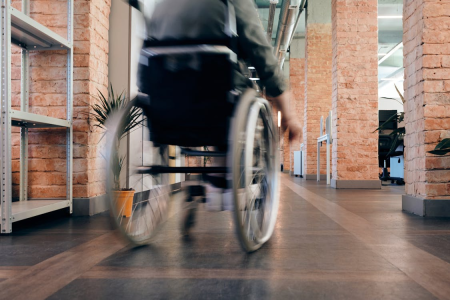What happens when your lift breaks and you use a wheelchair? This man found out the hard way
By
Maan
- Replies 0
Most of us expect to come home at the end of the day without any drama—especially after a long shift.
But when basic infrastructure fails, it can lead to unexpected consequences that hit harder for some than others.
One Melbourne resident found himself in an all-too-familiar battle that raises serious questions about accessibility and accountability.
Most Aussies look forward to heading home after work, switching off and settling in for the night. But for Shane Hryhorec, that simple daily routine turned into an exhausting ordeal—one that left him stuck, out of pocket, and still seeking answers.
The Melbourne man, who uses a wheelchair, had been warned through a social media group that the lift in his residential building wasn’t working. Concerned, he rang the lift company to flag his accessibility needs.
‘Long story short, I saw in our residential Facebook group that the lift had broken down. I called the lift company to let them know that I'm in a wheelchair and I need to get into my building. They said it had already been logged and someone was on their way,’ he said.
But when he returned home at 9:30 pm, there was no one on-site, no signage, and no clear update—just a lift out of order and a building he couldn’t enter.
‘I had to book a hotel and wear the same clothes for two days.’
The unexpected accommodation cost him $230, and that was just the beginning. On top of that, Shane had to toss his freshly purchased groceries, which had spoiled overnight.
‘The other thing that really upset me is I had gone shopping, so all $60 worth of food that needed to go in the fridge was ditched,’ he said. ‘Dairy and meat products had to go in the bin.’
Despite being a member of the building’s strata committee, Shane said communication remained sparse and frustrating. The following day, he was finally allowed back into his apartment—only to find himself stuck inside once again.
‘The next day they confirmed the lift was working and they let me into my apartment. They then had to continue working on it, which meant I couldn't then leave the building until it was resolved,’ he said.
The whole experience raised serious questions about what recourse—if any—exists for people with disabilities left in such situations.
‘What compensation is there for people with disabilities who get trapped in the lift but also can't get inside their building and have to book accommodation? None,’ he said. ‘That's what happened to me and I'm still out of pocket.’
Though this was the first time Shane had to organise overnight accommodation, he claimed the lift had failed numerous times during his seven-year residency in the building. He shared a photo of himself in his wheelchair, waiting beside his assistance dog, to highlight the ongoing issue.
Schindler, the lift company responsible, responded with Regional General Manager Callum Joyce stating that the company ‘continuously works to minimise elevator outages’ and acknowledged the importance of lift access in residential buildings.
According to Joyce, the lift hadn’t actually suffered a breakdown, but was undergoing a planned upgrade when an unexpected part failed.
‘During the planned upgrade, a part failed, which required replacement,’ he said. ‘The part was sourced from our warehouse in NSW, air-freighted overnight and delivered to site Friday morning...We provided regular updates and continued to communicate the status of the repair through to its completion.’
But the broader concern isn’t just about one lift or one building. Megan Spindler-Smith, Deputy CEO of People with Disability Australia, said these situations were far too common.
‘Sadly, this isn’t the first time we've heard of people with disability—including wheelchair users—being overlooked during emergencies. Lifts break down and things go wrong, but that’s exactly why buildings must have effective, inclusive plans in place,’ she said.
‘Everyone has the basic human right to access their home—or, at the very least, be provided with safe and reasonable alternatives.’
For Shane, those alternatives never came. And he’s still footing the bill.

When essential services fail and no backup plan is in place, who really pays the price? Let us know your thoughts in the comments.
In situations like Shane’s, many older Australians might wonder what safeguards are in place—not just for today, but for the future.
For seniors supporting adult children with disability, these everyday challenges highlight just how important long-term planning really is.
If you’ve ever worried about what will happen to your loved one when you’re no longer around, this earlier piece is well worth a read.
Read more: Ensuring your adult kids with disability are taken care of after you die
But when basic infrastructure fails, it can lead to unexpected consequences that hit harder for some than others.
One Melbourne resident found himself in an all-too-familiar battle that raises serious questions about accessibility and accountability.
The Melbourne man, who uses a wheelchair, had been warned through a social media group that the lift in his residential building wasn’t working. Concerned, he rang the lift company to flag his accessibility needs.
‘Long story short, I saw in our residential Facebook group that the lift had broken down. I called the lift company to let them know that I'm in a wheelchair and I need to get into my building. They said it had already been logged and someone was on their way,’ he said.
But when he returned home at 9:30 pm, there was no one on-site, no signage, and no clear update—just a lift out of order and a building he couldn’t enter.
‘I had to book a hotel and wear the same clothes for two days.’
The unexpected accommodation cost him $230, and that was just the beginning. On top of that, Shane had to toss his freshly purchased groceries, which had spoiled overnight.
‘The other thing that really upset me is I had gone shopping, so all $60 worth of food that needed to go in the fridge was ditched,’ he said. ‘Dairy and meat products had to go in the bin.’
Despite being a member of the building’s strata committee, Shane said communication remained sparse and frustrating. The following day, he was finally allowed back into his apartment—only to find himself stuck inside once again.
‘The next day they confirmed the lift was working and they let me into my apartment. They then had to continue working on it, which meant I couldn't then leave the building until it was resolved,’ he said.
The whole experience raised serious questions about what recourse—if any—exists for people with disabilities left in such situations.
‘What compensation is there for people with disabilities who get trapped in the lift but also can't get inside their building and have to book accommodation? None,’ he said. ‘That's what happened to me and I'm still out of pocket.’
Though this was the first time Shane had to organise overnight accommodation, he claimed the lift had failed numerous times during his seven-year residency in the building. He shared a photo of himself in his wheelchair, waiting beside his assistance dog, to highlight the ongoing issue.
Schindler, the lift company responsible, responded with Regional General Manager Callum Joyce stating that the company ‘continuously works to minimise elevator outages’ and acknowledged the importance of lift access in residential buildings.
According to Joyce, the lift hadn’t actually suffered a breakdown, but was undergoing a planned upgrade when an unexpected part failed.
‘During the planned upgrade, a part failed, which required replacement,’ he said. ‘The part was sourced from our warehouse in NSW, air-freighted overnight and delivered to site Friday morning...We provided regular updates and continued to communicate the status of the repair through to its completion.’
But the broader concern isn’t just about one lift or one building. Megan Spindler-Smith, Deputy CEO of People with Disability Australia, said these situations were far too common.
‘Sadly, this isn’t the first time we've heard of people with disability—including wheelchair users—being overlooked during emergencies. Lifts break down and things go wrong, but that’s exactly why buildings must have effective, inclusive plans in place,’ she said.
‘Everyone has the basic human right to access their home—or, at the very least, be provided with safe and reasonable alternatives.’
For Shane, those alternatives never came. And he’s still footing the bill.
Key Takeaways
- A Melbourne man who uses a wheelchair was stranded overnight after his building’s lift failed and cost him $230 in hotel fees.
- He lost $60 worth of groceries and was later trapped inside his apartment when further repairs continued.
- Despite contacting the lift company and being on the strata committee, Shane said communication was poor and no compensation was offered.
- Disability advocates say the incident highlights a wider issue of inadequate emergency planning for people with disabilities.
When essential services fail and no backup plan is in place, who really pays the price? Let us know your thoughts in the comments.
In situations like Shane’s, many older Australians might wonder what safeguards are in place—not just for today, but for the future.
For seniors supporting adult children with disability, these everyday challenges highlight just how important long-term planning really is.
If you’ve ever worried about what will happen to your loved one when you’re no longer around, this earlier piece is well worth a read.
Read more: Ensuring your adult kids with disability are taken care of after you die








